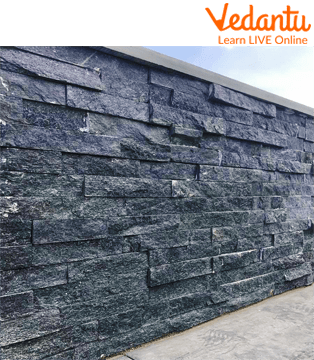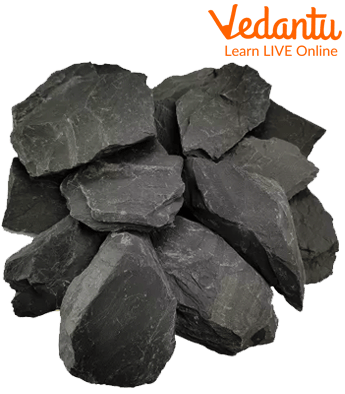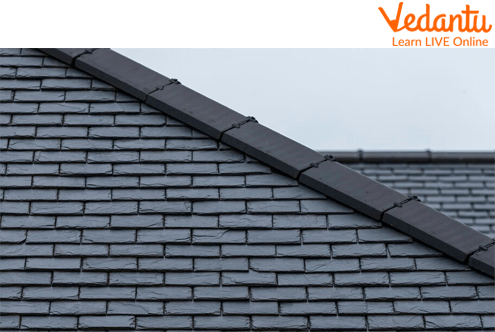




How Slate Rock is Used in Daily Life and Industry
Slate is a fine-grained, foliated metamorphic rock formed by the transformation of shale or mudstone by low-grade regional metamorphism. It is popular for various uses such as Roofing, Flagging, Flooring and Cladding, because of its stability and attractive appearance.

Slate Rock Cladding
Composition of Slate: Slate is composed primarily of clay minerals or maca, depending on the degree of metal change to which it has been subjected. Changing with increasing levels of heat and pressure in the original clay minerals in the shield. Slate may also contain abundant quartz and small amounts of feldspar, calcite, pyrite, hematite, and other minerals.

Slate Rock
How is Slate Used?
Most of the slate mined worldwide is used to produce roofing slate. Slate performs well in this application because it can be cut into thin sheets, absorb minimal moisture, and withstand cold water. The cost of slate and its installation is a disadvantage compared to other roofing materials. As a result, the new construction slate is mainly confined to high-end projects and prestige architecture.
Slate is also used for interior flooring and cladding, exterior paving, dimension stone, and decorative aggregate. Historical slate for chalkboards, student writing slate, billiard tables, cemetery markers, whetstones, and table tops has been used. Because it is a good electrical insulator, it was also used for early electrical panels and switch boxes.

Slate Rock Roofing
Why is Slate Used for Pool Tables?
Slate is solid rock with fine grains composed of several minerals, including quartz, clay and mica. It is ideal for pool tables because it naturally splits into wide, flat pieces, and can be easily ground and polished into a perfectly flat surface. While heavier and more expensive than wood, slate ensures that the playing surface remains smooth and level.
Table tops made of wood, as well as synthetics, can warp quite easily. Because it is so durable and is known to last, many manufacturers will offer a lifetime warranty for slate pool tables.
Solved Questions
Name the minerals content in slate rock.
Ans: Apatite, biotite, chlorite, feldspar, graphite, hematite, kaolinite, magnetite, pyrite, tourmaline and zircon are the minerals content in slate rock.
Write two uses of slate rock.
Ans: Roofing and flooring are the two uses of slate rock.
Write one disadvantage of slate.
Ans: Slate is costlier than other materials. This is the biggest disadvantage of slate.
Summary
In this chapter, we have seen many things related to Slate. Now we know what Slate is and its composition. We have also seen many uses of slate and also know why we can use Slate. Slate is also used for billiard tables, the same way as we have seen for pool tables. There are also some properties and advantages of slate and disadvantages that we discussed.
Learning by Doing
Write True or False.
Slate is a sedimentary rock.
Slate is formed from shale or mudstone.
Slate is used for Pool tables.
Slate is cheaper than other rocks.
FAQs on Uses of Slate Rock: Practical Applications & Key Facts
1. What is slate rock?
Slate is a type of metamorphic rock. This means it was originally another kind of rock, like shale or mudstone, which was transformed deep within the Earth by intense heat and pressure. This process makes slate very strong and gives it a unique ability to split into thin, smooth layers.
2. What are the main uses of slate rock in daily life?
Slate is a very versatile rock with many applications. Some of its most common uses include:
- Roofing: Its thin, waterproof tiles are famously used to cover the roofs of buildings.
- Flooring: It is used to make durable and elegant floor tiles for homes and buildings.
- Writing Slates: Historically, it was used to make blackboards for classrooms and small writing slates for students.
- Decoration: Slate is often used in gardens for pathways, walls, and other decorative features.
- Kitchenware: In modern homes, you can find slate used for serving platters and coasters due to its non-porous and stylish nature.
3. How is slate formed?
Slate is formed through a natural process called metamorphism. It begins as a sedimentary rock like shale or mudstone, made from clay or volcanic ash. Over millions of years, this rock gets buried deep underground. The immense heat and pressure from the Earth's crust squeeze and bake the rock, rearranging its minerals into the hard, layered slate we use today.
4. What are the key properties of slate that make it so useful?
Slate's usefulness comes from its unique combination of properties. The most important characteristics are:
- Foliation: It naturally splits into thin, flat sheets, which is perfect for making tiles.
- Durability: It is a very hard and long-lasting rock that can withstand harsh weather for many years.
- Low Water Absorption: Slate is not very porous, meaning it doesn't soak up water easily. This makes it waterproof and resistant to frost damage.
- Fireproof and Insulating: It does not burn and is a poor conductor of electricity, which made it useful for early electrical switchboards.
5. Why is slate a popular choice for roofing material?
Slate is an excellent material for roofing primarily because it is highly durable and waterproof. Its low water absorption rate prevents rain from leaking into a house and protects the roof structure from rot and frost. Furthermore, since slate can be split into relatively thin tiles, it provides robust protection without adding excessive weight to the building's frame. Its natural beauty and long lifespan also make it a valuable choice.
6. How is slate different from other rocks like marble or granite?
Yes, slate is very different from marble and granite in its formation and properties. Slate is a metamorphic rock formed from fine-grained clay and mud, which gives it a distinct, layered structure. Marble is also a metamorphic rock but forms from limestone and has an interlocking crystalline texture. Granite, on the other hand, is an igneous rock, formed from cooled magma, and has a speckled, granular appearance. The key difference is that slate splits easily into thin sheets, whereas marble and granite do not.
7. What are the common colours of slate?
While many people think slate is only grey, it actually comes in a variety of colours. The specific colour is determined by the minerals present during its formation. The most common colour is grey, in many shades from light to dark. However, slate can also be found in beautiful shades of green, red, black, purple, and brown.





















